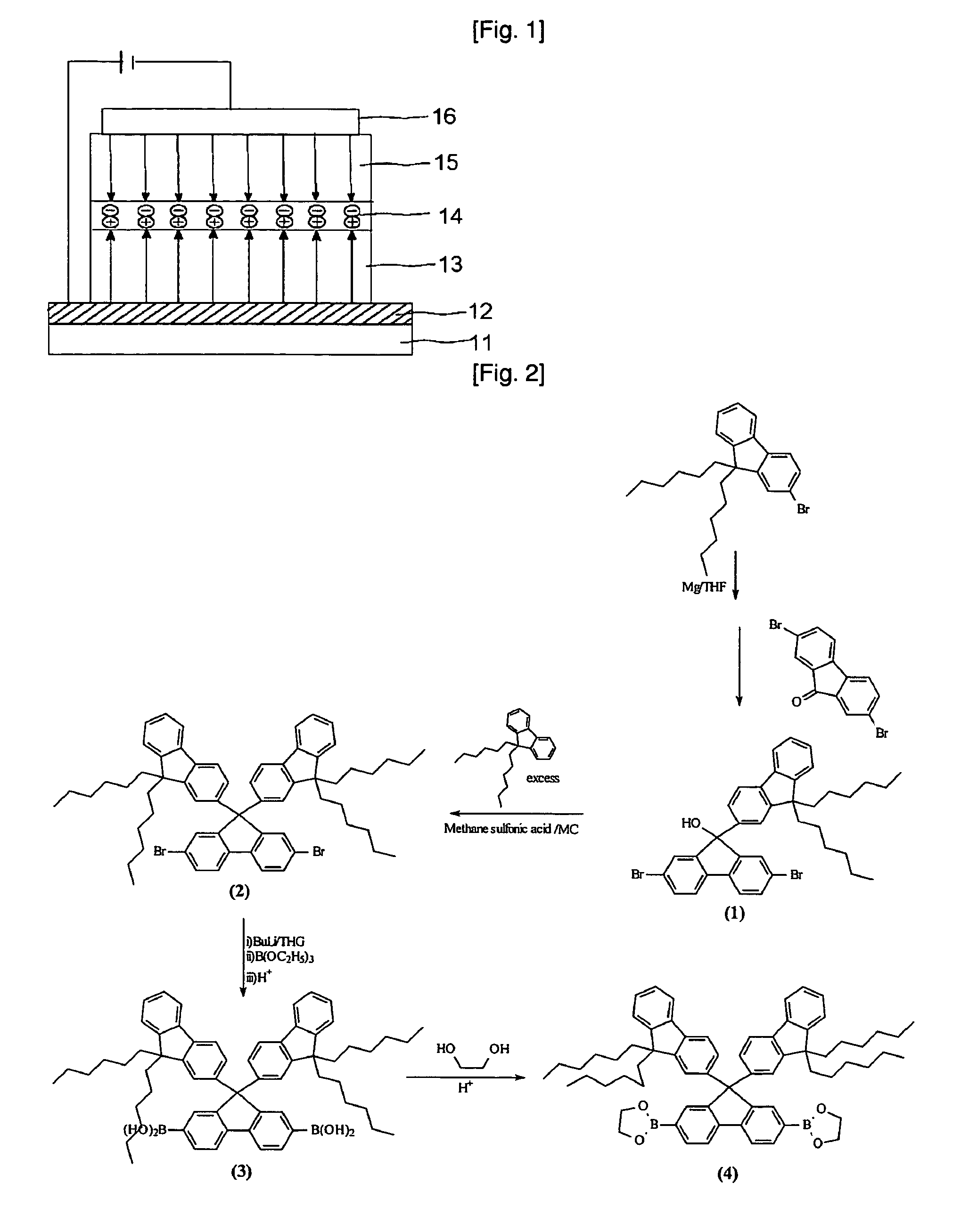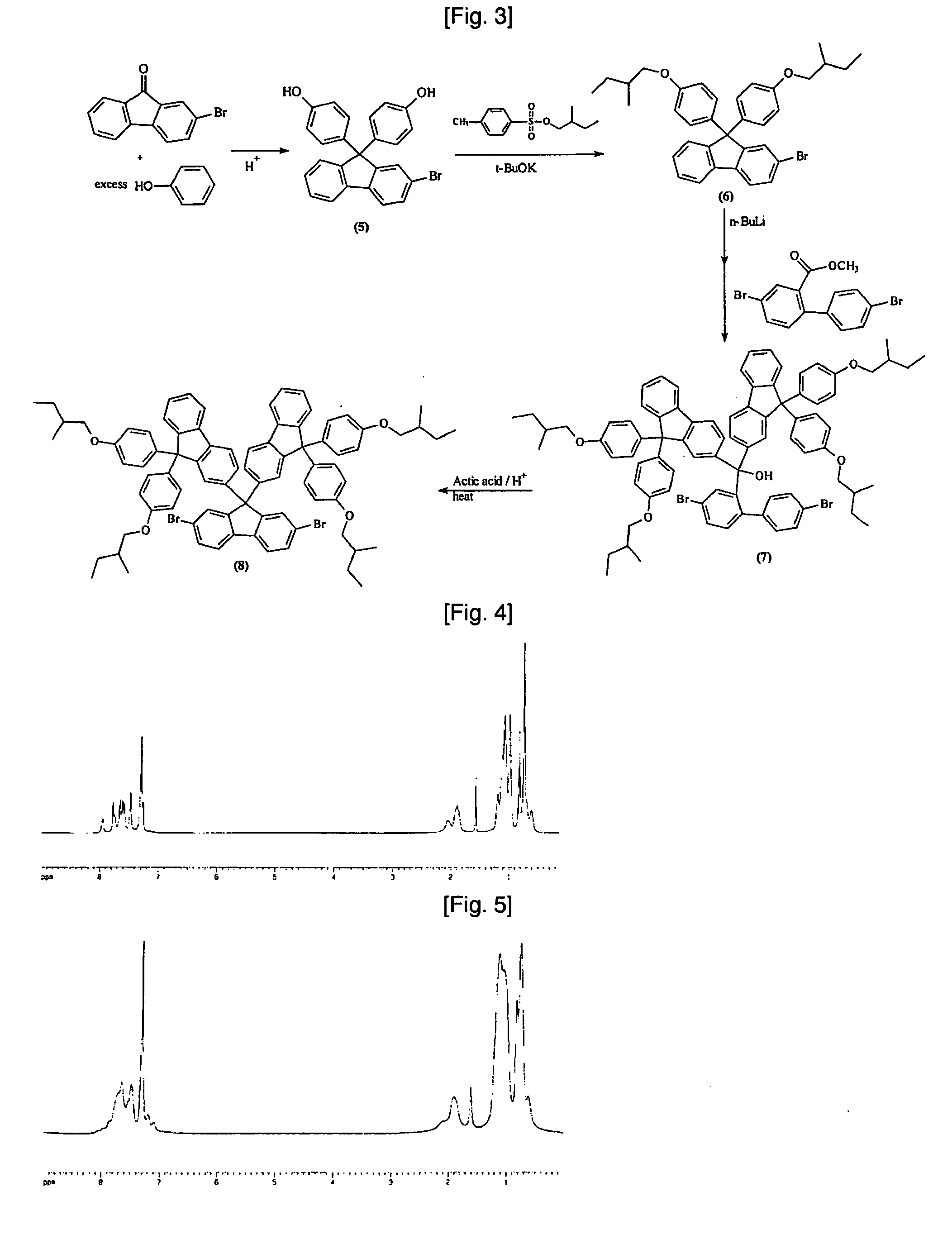Organic electroluminescent polymer having 9,9-di(fluorenyl)-2,7-fluorenyl unit and organic electroluminescent device manufactured using the same
a technology of fluorene and organic electroluminescent polymers, which is applied in the direction of luminescent compositions, chemistry apparatuses and processes, and other domestic articles, can solve the problems of low processibility or heat stability, negatively affecting the luminous efficiency or service life of the device, and low-molecular weight materials that cannot be used for inkjet printing or spin coating, etc., to achieve high luminous efficiency, high solubility, and superior heat stability
- Summary
- Abstract
- Description
- Claims
- Application Information
AI Technical Summary
Benefits of technology
Problems solved by technology
Method used
Image
Examples
example 1
Synthesis of (9-(9,9-dihexylfluoren-2-yl)-2,7-dibromofluoren-9-ol) (1)
[0099] To 5.64 g of Mg placed into a 1000 ml three-neck flask, 80 g of 9,9-dihexyl-2-bromofluorene in 300 ml THF was slowly added dropwise, to prepare a Grignard reagent. After a temperature of a reaction chamber was decreased to −40° C. or less, 52 g of 2,7-dibromofluorenone was added to the reaction bath in a nitrogen atmosphere. The temperature was gradually increased to room temperature, followed by stirring for 10 hours. The resulting reaction solution was poured into water, after which an extraction was performed using diethyl ether. The solvent was evaporated using a rotary evaporator. A column chromatography separation resulted in 60 g (58%) of (9-(9,9-dihexylfluoren-2-yl)-2,7-dibromofluoren-9-ol) (1).
example 2
Synthesis of (9,9-di(9,9-dihexylfluoren-2-yl)-2,7-dibromofluorene) (2)
[0100] In a 2 L round-bottom flask, 50 g of the compound (1) and 200 g of 9,9-dihexylfluorene were dissolved in 1000 ml of dichloromethane, and then the temperature was decreased to 0° C. The reaction solution was slowly added with a s olution of 10 ml of methane sulfonic acid dissolved in 100 ml of dichloromethane with stirring, followed by further stirring for 2 hours. The resulting reaction solution was poured into water, after which an extraction was performed using diethyl ether. The solvent was evaporated using a rotary evaporator. A column chromatography separation resulted in 60 g (58%) of (9,9-di(9,9-dihexylfluoren-2-yl)-2,7-dibromofluorene) (2).
example 3
Synthesis of (9,9-di(9,9-dihexylfluoren-2-yl)fluorene-2,7-diboronic acid) (3)
[0101] In a 250 ml round-bottom flask, 10 g of the compound (2) was dissolved in 60 ml of THF, and then the temperature was decreased to −70° C. 2 equivalents of 2.5 M n-butyllithium were slowly added to the above reaction solution, and the reaction occurred at a low temperature (−70° C. to −40° C.) for 2 hours. Also, 4 equivalents of triethyl borate were added at the same temperature and the obtained reaction solution was allowed to stand for 12 hours. The resultant reaction solution was added to 3 N HCl aqueous solution, followed by stirring for 4 hours and extraction with diethyl ether. The solvent was removed using a rotary evaporator, to obtain a solidified material, which was then washed several times with toluene, to yield 3.6 g (39%) of (9,9-di(9,9-dihexylfluoren-2-yl)fluorene-2,7-diboronic acid) (3).
PUM
| Property | Measurement | Unit |
|---|---|---|
| Fraction | aaaaa | aaaaa |
| Fraction | aaaaa | aaaaa |
| Nanoscale particle size | aaaaa | aaaaa |
Abstract
Description
Claims
Application Information
 Login to View More
Login to View More - R&D
- Intellectual Property
- Life Sciences
- Materials
- Tech Scout
- Unparalleled Data Quality
- Higher Quality Content
- 60% Fewer Hallucinations
Browse by: Latest US Patents, China's latest patents, Technical Efficacy Thesaurus, Application Domain, Technology Topic, Popular Technical Reports.
© 2025 PatSnap. All rights reserved.Legal|Privacy policy|Modern Slavery Act Transparency Statement|Sitemap|About US| Contact US: help@patsnap.com



